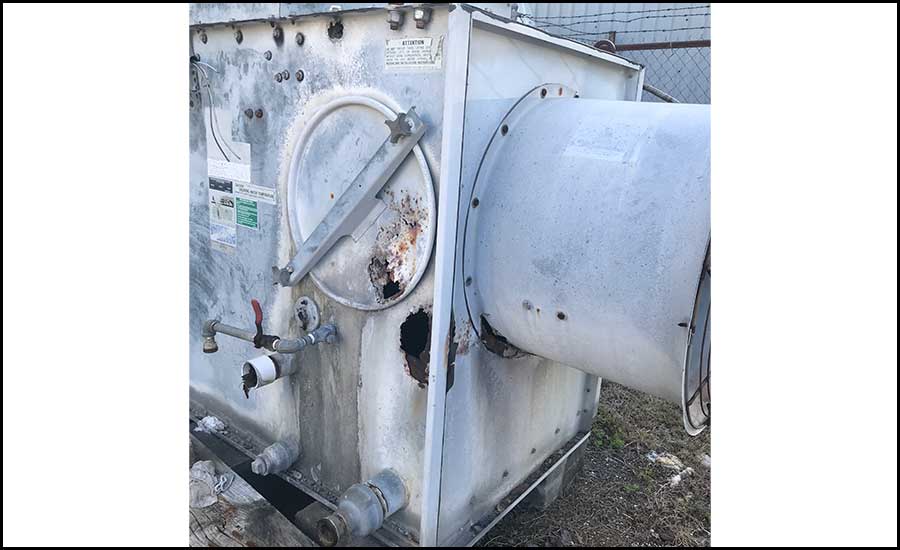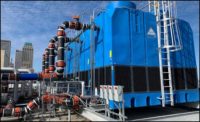Fed up with spending substantial resources on the continuous repair of an aging cooling tower, a large North Carolina community college recently opted to replace its failing galvanized-metal unit with an engineered plastic model. In doing so, it realized significant reductions in maintenance costs along with impressive gains in efficiency.
Established in 1961, Fayetteville Technical Community College currently serves over 28,000 students on its 150-acre campus. However, the college had struggled for some time trying to cool one of its academic buildings due to a galvanized metal cooling tower used in conjunction with the facility's HVAC system which had fallen into disrepair.
Located outside and subjected to the elements, the tower was plagued by rust and corrosion causing it to leak substantially. A previous overhaul combined with continuous maintenance, replacement parts, ongoing seam welding, and water loss were costing the college thousands of dollars each year in upkeep.
“The existing cooling tower was beyond its life expectancy and its performance was failing,” said Gene Maynor, division manager of Haire Plumbing and Mechanical, a commercial industrial plumbing and mechanical HVAC provider serving the college and other area organizations and businesses. “It was pretty much just falling apart and that was even after it was renewed in 2014.”
In fact, not long after being refurbished at a cost of about $30,000, the leaking continued and the tower’s performance began to suffer dramatically. When the unit was unable to maintain the temperature setpoint needed to properly cool the large academic building, the facilities director decided it was time to stop spending money on Band-Aids and invest in a new cooling tower.
“The cooling tower is the heartbeat of the cooling system for the facility,” Maynor said. “The air conditioning system goes beyond just providing comfortable conditions for the students and faculty.
“It also controls the humidity and plays a major role in indoor air quality. So, it was important that the tower was strong and fully functional.”
THE HDPE COOLING TOWER SOLUTION
Two of the campus’ seven metal-clad cooling towers had previously been replaced with new towers constructed of high-density polyethylene (HDPE). Following positive experiences with those installations, the college’s facilities director insisted on another HDPE design when replacing this problematic cooling tower. While there are other materials of construction available, including galvanized metal, stainless steel, and fiberglass, HDPE towers are nearly maintenance-free and prove easier and faster to install.
Together Maynor and the facilities director selected a TM Series 310-ton HDPE cooling tower from Delta Cooling Towers. The TM Series induced draft cooling tower features a modular design and a seamless, engineered-plastic (HDPE) shell with corrosion-proof construction and a leak-proof design.
Typically, metal towers arrive with numerous pieces that need to be assembled and erected on site. The engineered-plastic cooling tower selected by the college came factory assembled in two pieces.
“We basically pulled the truck up for delivery, had a crane on site for 30 minutes to set the tower, and then were ready to go,” Maynor said.

“The Locomotive,” as it was known, was noisy and leaky.
The double-wall shell of the new plastic cooling tower does not have seams that are often the source of leaking. The material is also non-corroding even when exposed to the outdoor weather extremes of North Carolina. The direct-drive fan assembly consists of a fan ring, propeller, motor, and guard, so there are fewer moving parts to service. Together, these features significantly reduce cooling tower maintenance at the college.
“Typically, I’m putting out fires all day, every day when it comes to metal-clad towers” Maybor said. “But I have not seen any of the college’s three HDPE towers since I walked away from the installations.”
The tower comes with a 20-year warranty.
INCREASED SUSTAINABILITY AND EFFICIENCY
In addition to eliminating the water waste caused by the leaking metal tower, the campus is using less water to operate the more modern HDPE cooling tower, which features a water distribution system capable of increasing flow conditions with minimal increase to inlet pressure.
The campus has also seen a decrease in its energy usage thanks to the VFD driving the air movement.
“The college is experiencing a 20% to 30% reduction in electricity consumption on this tower because the fan adjusts its speed according to the weather and the demands of the system,” Maynor said.
Another advantage is noise reduction.
“They called the old cooling tower ‘The Locomotive’ around campus because it sounded like a train. You couldn’t even hold a conversation if you were standing near it,” Maynor said. “Once we installed the new tower, the employees and maintenance staff were shocked by how quietly it operated.”
The college is on track to have all its metal-clad towers replaced with high-efficiency, low-noise engineered plastic towers within the next several years.


